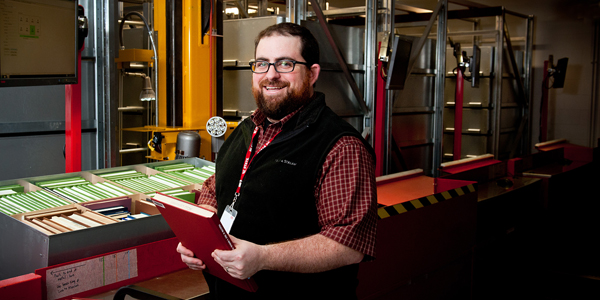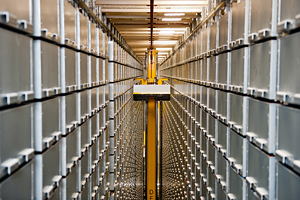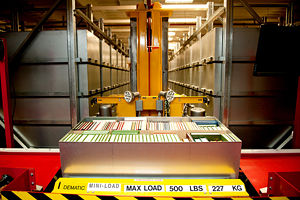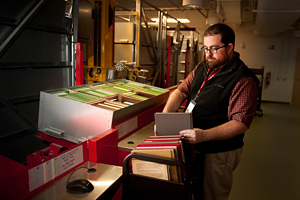The bookBot’s Human Component

Carl Piraneo is one of four library technicians tasked with operating and maintaining the bookBot, the huge robotic book retrieval system in the new James B. Hunt Jr. Library on Centennial Campus. The Bulletin sat down with Piraneo to find out what it’s like working with the futuristic system.
What are your main work responsibilities?
I help maintain the library’s entire collection. We have between 30,000 and 40,000 books on the shelves in the public area of the library. The bookBot currently stores about 1.5 million books and materials, including NC State’s special collections, as well as the collections for engineering, textiles and computer science.
How did you learn to operate the bookBot?
Representatives from Dematic, the manufacturer, spent a week training me and three other technicians on how to work the software and perform mechanical maintenance. Keeping operators to a minimum helps avoid too many hands in the pot—there are many safety issues.

Describe your work day.
Every morning we perform general maintenance on all four robots. We run the lift carriages (the trays that pull the bins in and out). We ensure everything is in the right place and functioning. We perform a weekly, monthly and quarterly checklist—almost like an automaker’s manual. Each week we climb 50 feet up the ladder, with a harness, all the way to the top. We check that every bolt is tight and that no wires are bent.
You don’t get vertigo?
The first few times were definitely spooky—I might have sweated a little—but now I’m good. Climbing up is fun, I enjoy it.
How else do you spend your day?
We retrieve books, store books, handle inter-library loan requests and take inventory. Storing books is interesting because the bookBot has a random storage system—no book goes where it was previously. We scan the barcode and the system finds the closest bin to the operator with available space. Over time, popular items will filter their way to the front, making retrieval faster. It is a busy job.

How frequently is the bookBot used?
A lot—the 19 other universities in the country with a bookBot use it more as an archive. We store items we expect people to use to allow more library space for study rooms and technology.
Currently we have 1.5 million items, including books, journals, microfilm, manuscripts, film and government documents stored in our bookBot.
How does the system work?
The bookBot tracks each item by its barcode. During last year’s book move we spent six months physically scanning the barcode of each item. Our top safety rule is: stand back and never touch the robot. Because this is controlled remotely you never know when it will move. Everyone enjoys the “no riders” safety sign, but this is serious stuff. Nobody wants to get caught.

Do your family and friends think your job is awesome?
Yes. Years ago my father-in-law, an electronic shop supervisor at NC State, told me they would build a library on Centennial Campus with robots. I thought he was crazy. When I actually saw the system, it was impressive. Few university libraries have viewing windows like ours so people can watch the bookBot work. This is a real symbol of pride for the university.
What’s the best part about working with the bookBot?
Every time the robot goes to a bin, there’s always something slightly different. It’s still exciting.
What’s the best part about working at NC State?
One favorite is my wife works in landscape construction services and helped install the landscape around the Hunt Library. So sometimes in my daily work flow, I get to see my wife.
- Categories:


